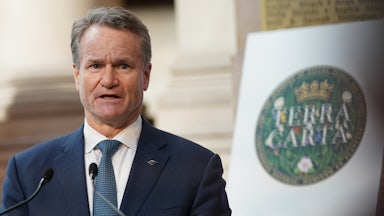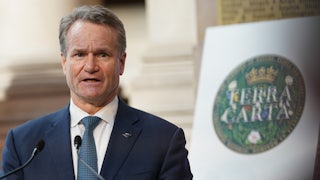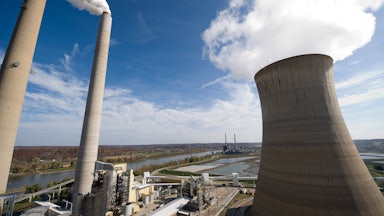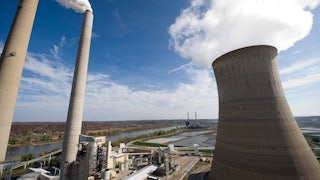In early May, the United States Federal Reserve ordered the largest interest rate hike in over 20 years. This week, Fed Chair Jerome Powell declared he “won’t hesitate” to go even further, calling action on inflation an “unconditional need.”
This urgency to maintain price stability highlights a disturbing contrast at the heart of U.S. monetary policy: As the Fed goes all out to curb inflation, it continues to ignore a far more profound threat to our economic and financial stability—climate change.
By the year 2100, according to one study, the high-end cost of unchecked climate change could be $551 trillion. That’s more money than currently exists on earth. Yet just last year, Powell told a panel of his global colleagues, “Today, climate change is not something that we directly consider in setting monetary policy.”
Such a head-in-the-sand approach to climate is simply not compatible with a livable future, given the critical role that fossil fuel finance plays in driving this crisis. A recent report found that the world’s 60 largest banks invested $4.6 trillion in fossil fuels in the six years since the adoption of the Paris Agreement, with four U.S. banks—JPMorgan Chase, Citi, Wells Fargo, and Bank of America—together accounting for one-quarter of all fossil fuel financing. The Fed has the power and the responsibility to rein in these disastrous investment patterns, both to insulate our financial system from the contagious collapse of a dead-end fossil fuel industry and to protect the U.S. economy from the ravages of climate change.
Thus far, however, the Fed has failed to take any meaningful action on climate. This contrasts sharply with its peer institutions around the world. The European Central Bank has announced policies that make green assets eligible for purchase or discount. The Bank of England is actively exploring climate-related capital requirements and has committed to reducing the carbon intensity of its corporate bond purchasing program. The People’s Bank of China and the Bank of Japan have launched dedicated lending facilities to offer discounted funding for clean energy—and the list goes on.
The Fed, alone, has refused to acknowledge that climate requires an active central bank response, with opponents arguing that such actions exceed the statutory limits placed upon the Fed by Congress. This argument both misreads the Fed’s legislative mandates and underestimates the profound havoc that climate devastation will wreak on our financial system. In truth, the Fed’s legislative directives not only allow it to take steps to prevent and mitigate climate change, they actually require the Fed to do so.
To begin with, the Fed has been directed by Congress to maintain the safety and soundness of individual banking institutions—a task it cannot fulfill while ignoring the physical risks that climate disasters pose to bank properties and the transition risks that will transform so many fossil fuel investments into stranded assets. There are countless ways these risks could reduce the solvency of debtors and create pathways to the kinds of default waves that threaten bank soundness, directly implicating the Fed’s supervisory responsibilities.
The Fed has also been charged by Congress with protecting the broader stability of the U.S. financial system. Dodd-Frank was passed in 2010 to prevent the problems that gave rise to the 2008 financial crisis and create a new regulatory framework for the twenty-first century. To those ends, the statute requires the Fed to craft “enhanced … prudential standards” for the largest financial institutions in order to “prevent or mitigate risks to the financial stability of the United States.”
It’s clear the Fed can’t fulfill this obligation if it continues to ignore climate change, a planetary crisis threatening practically every form of economic production available to us. Indeed, a 2019 study found that climate change will increase the frequency of banking crises by between 26 and 248 percent and that rescuing these banks will cause a fiscal burden of approximately 5 to 15 percent of gross domestic product per year. These are precisely the kinds of threats that Dodd-Frank directed the Fed to prevent. What’s more, the agency already has the macroprudential regulatory tools—like increased capital and margin requirements for fossil fuel financing—to make banks account for the riskiness of climate-exacerbating investments and begin to shed these assets.
Finally, there are the Fed’s monetary policy tools, which Congress authorized to promote “maximum employment, stable prices, and moderate long-term interest rates.” These objectives are simply not achievable in a world of constant superstorms, extreme heat, endless drought, rising seas, and other climate catastrophes. Even in the shorter term, climate disasters can damage the economy and impact aggregate supply and demand—for example, extreme weather events are linked to food price shocks, which can have profound inflationary effects. Therefore achieving the Fed’s triple mandate in the years to come requires enacting climate-related monetary policy. For example, the Fed could change its discount window lending practices to make fossil fuel–related collateral ineligible for its lender-of-last-resort assistance, placing an immense amount of pressure on financial institutions to drop these assets. The Fed could also join a number of its peer institutions in increasing its portfolio of green bonds, supporting climate action by state, county, and municipal governments under Section 14 of the Federal Reserve Act and potentially directing resources toward private-sector decarbonization efforts under Section 13(3).
These monetary strategies are particularly important right now because, unlike traditional agency action, which the Supreme Court has proven so eager to strike down, the courts have regularly ruled that monetary policy is practically invulnerable to judicial review. Indeed, the precedent-setting case on this, Raichle v. Federal Reserve Bank of New York, stresses that “the correction of discount rates by judicial decree seems almost grotesque”—meaning there are likely no federal administrative actions on climate more resistant to being overturned than the Fed’s monetary policies.
So what, then, is holding the Fed back? One argument deployed by fossil fuel allies is that Fed climate action conflicts with the principle of central bank independence. As Republican Senator Pat Toomey warned last year, engaging with climate “inserts the Federal Reserve into the emotionally-charged political arena—a place where the Federal Reserve seldom has ventured, and for good reason.”
This argument badly misinterprets the fundamental purpose of Fed independence—a purpose that is often illustrated by former Fed Chairman Paul Volcker’s “war on inflation.” In the late 1970s, Volcker used deflationary monetary policy to actively cause a major recession. Though this generated massive backlash and caused enormous pain for working families, Volcker stood firm, and he’s been lionized for doing so. As former Fed Chairman Ben Bernanke said upon Volcker’s death, “He came to represent independence. He personified the idea of doing something politically unpopular but economically necessary.” While climate action is extremely popular—a recent poll found that two-thirds of Americans want the federal government to do more to combat climate—such celebrations of Volcker’s legacy show that the Fed was never designed to stick to neutral or apolitical courses of action.
In reality, the entire purpose of Fed independence was, and is, to allow the agency to tackle critical issues related to its statutory mandates, regardless of how controversial or thorny they might be. To this end, Fed policymakers have regularly experimented with—and then mainstreamed—novel strategies in response to newly arising challenges in the real world. During the 2008 financial crisis, the Fed broke previously held norms by purchasing assets from troubled financial institutions like JPMorgan Chase and AIG. In the years after 2008, the Fed innovated in its usage of quantitative easing and its development of the federal funds rate. And when Covid-19 hit, the Fed spearheaded a new series of lending facilities offering direct support to corporations, local governments, and consumers. Powell’s explanation for these unorthodox steps exemplifies how the Fed continuously redraws the boundaries of its mission and practice. “We crossed a lot of red lines that had not been crossed before,” he explained last year. But in a crisis, “you do that and you figure it out afterward.”
Today, humanity faces an existential crisis that threatens every aspect of our civilization, including our financial and economic stability. Fortunately, the Fed has an array of tools at its disposal that could make a material difference in protecting our world from climate disaster. Utilizing these tools isn’t just good policy—it’s the law. And it may just be our last, best chance at securing a livable future.










